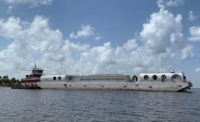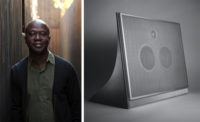Before last December, the large “9” painted in black on the front of an odd-looking house in Barnegat Light, New Jersey, was a rarely noticed anomaly in an ordinary beach community. Only when the house was scheduled for possible demolition by its new owner, a developer, did the public find out that number 9 was the address of Lieb House, designed by the groundbreaking firm Venturi and Rauch in 1969, the same year Denise Scott Brown was added as a third partner. Built after Robert Venturi’s famous home for his mother (1964), it is a seminal work of Pop architecture. Using cheap materials such as asbestos siding and off-the-shelf windows in ironic ways, it brings attention to its own ordinary qualities while subverting those same conventions. “It’s a real dumb house, just a box, but it’s gorgeous,” its owner, Judy Lieb, stated in a 1970 New York Times article, impervious to her neighbors’ occasional objections.
Concerned about its fate, Sheila Ellman, who subsequently owned the house for nearly 30 years before selling it to the developer, frantically called New York architect (and former Venturi, Rauch and Scott Brown employee) Frederic Schwartz. He contacted James Venturi (working on a documentary about his parents’ career, Learning from Bob and Denise), who then rang up Robert Gotkin and Deborah Sarnoff, patrons of his film and owners of a 1985 house designed by Venturi and Scott Brown in Glen Cove, New York. They agreed to take the Lieb House onto their land on the Long Island Sound, where it would form a pair with its younger relative. The team worked quickly to save the house, which, due to the developer’s existing contracts, needed to be off-site by February 1, 2009.
The younger Venturi and Schwartz soon found Wolfe House Movers, a Pennsylvania-based company that conducts about 100 house moves a year, often of historic or endangered structures. They were satisfied with the reasonable, low-six-figure price and impressed with the thoroughness of Wolfe’s approach (the firm designs and manufactures much of its own equipment). The operation involved removing the skirting wall that obscured the house’s crawl space, which left the pilings and undercarriage exposed. The movers put steel I-beams between the 8-foot on-center pilings, severed the house from those pilings along its main beam, and lifted it incrementally over the course of two days. A hydraulic jacking machine allowed a uniformly level lift, causing only minimal stress damage throughout the process. A power dolly moved the house off the site and down the road, where it encountered low-hanging telephone wires that required the dolly to be lowered to just 2 inches off the ground. The 1,835-square-foot house arrived in a waterside parking lot, where it sat for a few weeks before taking to the water for its 16-hour trip up the eastern seaboard, passing Lower Manhattan’s Pier 19 and a crowd of spectators and the media. According to Jamin Buckingham, Wolfe’s project manager, it was a very routine operation—even though he hadn’t moved a house by barge before—even easier, weather-permitting, than dealing with power lines and traffic lights on roads.
A final obstacle was the new site: It sits on a shoreline area classified as wetland. New York’s Department of Environmental Conservation (DEC) required a permit to unload the house at that location, approval of which can take months. A key drawing produced by Schwartz’s office persuaded the DEC that the house could be brought onto land at high tide without damaging the shoreline. A ramp was assembled to negotiate the 10-foot height difference between the barge and the higher land, with the dolly tilting against the grain as the slope increased.
Schwartz’s firm is taking charge of the restoration—which includes replacing the removed skirting and concrete stairs, repainting the lost two-tone color scheme, and adding a fresh number 9—but it is proceeding intentionally slowly. “We’re going to let the clients live with the house a little,” he says. Placed onto pilings in early April, it now sits on the circular driveway of the site’s existing house, 90 degrees off of its original orientation, but with distant views of Manhattan visible from the second-floor deck. Schwartz found a material that is identical to the original asbestos siding (minus the asbestos) to begin the exterior restorations. Changes are also expected for the interiors. The four narrow bedrooms on the first floor, originally designed for a young family, may become two. “That’s the fate of architecture,” Robert Venturi says. “I call it the most fragile medium. Unlike the Parthenon or the Pantheon, it doesn’t necessarily last very long. But we’re lucky, it’s a wonderful circumstance, and the fact that it’s a different context, that happens to work okay.”










Post a comment to this article
Report Abusive Comment